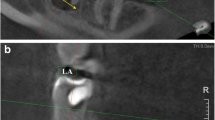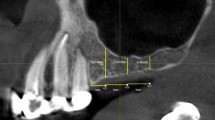Abstract
Purpose
The goal of this work was to examine the relationship between sagittal facial pattern and thickness of alveolar bone in conjunction with root morphology of teeth by using cone beam computed tomography (CBCT).
Methods
The study was carried out on the CBCT scans from 3 group of patients (n = 20 in each group). The first group involved skeletal class 1, the second group involved skeletal class 2, and the third group involved skeletal class 3 patients. In all, 14 permanent teeth and interdental regions in the maxilla and mandible were evaluated. Root length and root width were measured on each tooth. Buccal cortical bone thickness, cancellous bone thickness, and lingual cortical bone thicknesses were measured in each interdental region. Analysis of variance, Kruskall–Wallis H and Mann–Whitney U tests were used for statistical comparisons.
Results
No significant difference was found between the groups for root length, root width, buccal cortical bone and lingual cortical bone thickness. A significant difference was observed between the groups for cancellous bone thickness as it was thicker in skeletal class 2 group. Cortical bone was thicker in the mandible compared to maxilla on both buccal and lingual sides and it was thicker in the posterior region compared to the anterior region on the buccal side.
Conclusions
Differences in cancellous bone thickness between different sagittal facial patterns and differences in cortical bone thickness between different alveolar regions should be taken into consideration when planning orthodontic tooth movements and anchorage mechanics.
Zusammenfassung
Ziel
Ziel der vorliegenden Studie war es, die Beziehungen zwischen der sagittalen skelettalen Klasse und der Dicke des Alveolarknochens sowie der Zahnwurzelmorphologie mittels digitaler Volumentomographie (DVT) zu untersuchen.
Methoden
Die Studie wurde an DVTs von drei Patientengruppen durchgeführt. In der ersten Gruppe waren Patienten mit skelettaler Klasse 1 (n = 20), in der zweiten Patienten mit skelettaler Klasse 2 (n = 20) und in der dritten Gruppe Patienten mit skelettaler Klasse 3. Insgesamt wurden 14 bleibende Zähne und Interdentalbereiche in Ober- und Unterkiefer bewertet. Wurzellänge und Wurzelbreite wurden an jedem Zahn gemessen. In jeder Interdentalregion wurde die Dicke der bukkalen und lingualen Kortikalis sowie der Spongiosa bestimmt. Zur statistischen Auswertung dienten Varianzanalysen, Kruskal-Wallis-H- und Mann-Whitney-U-Tests.
Ergebnisse
Es wurde kein signifikanter Unterschied zwischen den Gruppen in Bezug auf Wurzellänge, Wurzelbreite, Dicke der bukkalen und lingualen Kortikalis festgestellt. Es wurde ein signifikanter Unterschied zwischen den Gruppen für die Spongiosadicke beobachtet, die bei Patienten mit skelettaler Klasse 2 dicker war. Kortikaler Knochen war im Unterkiefer im Vergleich zum Oberkiefer sowohl auf der bukkalen als auch auf der lingualen Seite dicker und im posterioren im Vergleich zum anterioren Bereich auf der bukkalen Seite dicker.
Schlussfolgerungen
Bei der Planung von orthodontischen Zahnbewegungen und der Verankerungsmechanik sollten die Unterschiede in der Dicke der Spongiosa zwischen verschiedenen sagittalen skelettalen Klassen und die Unterschiede in der Kortikalis zwischen den verschiedenen Alveolarregionen berücksichtigt werden.







Similar content being viewed by others
References
Al-Masri MM, Ajaj MA, Hajeer MY, Al-Eed MS (2015) Evaluation of bone thickness and density in the lower incisors’ region in adults with different types of skeletal malocclusion using cone-beam computed tomography. J Contemp Dent Pract 16:630–637
Baumgaertel S (2010) Predrilling of the implant site: is it necessary for orthodontic mini-implants? Am J Orthod Dentofacial Orthop 137:825–829
Baysal A, Ucar FI, Buyuk SK, Ozer T, Uysal T (2013) Alveolar bone thickness and lower incisor position in skeletal Class I and Class II malocclusions assessed with cone-beam computed tomography. Korean J Orthod 43:134–140
Buschang PH, Carillo R, Ozenbaugh B, Rossouw PE (2008) 2008 survey of AAO members on miniscrew usage. J Clin Orthod 42:513–518
Carranza FA, Bernard GW (2002) The tooth-supporting structures. In: Carranza F, Newman M, Takei H (eds) Clinical periodontology, 9th edn. W. B. Saunders, Philadephia, pp 45–52
Daegling DJ, Hotzman JL (2003) Functional significance of cortical bone distribution in anthropoid mandibles: an in vitro assessment of bone strain under combined loads. Am J Phys Anthropol 122:38–50
Deguchi T, Nasu M, Murakami K, Yabuuchi T, Kamioka H, Takano-Yamamoto T (2006) Quantitative evaluation of cortical bone thickness with computed tomographic scanning for orthodontic implants. Am J Orthod Dentofacial Orthop 129(721):e7–12
Enhos S, Uysal T, Yagci A, Veli I, Ucar FI, Ozer T (2012) Dehiscence and fenestration in patients with different vertical growth patterns assessed with cone-beam computed tomography. Angle Orthod 82:868–874
Eraydın F, Germec-Cakan D, Tozlu M, Ozdemir FI (2018) Three-dimensional evaluation of alveolar bone thickness of mandibular anterior teeth in different dentofacial types. Niger J Clin Pract 21:519–524
Farnsworth D, Rossouw PE, Ceen RF, Buschang PH (2011) Cortical bone thickness at common miniscrew implant placement sites. Am J Orthod Dentofacial Orthop 139:495–503
Fayed MM, Pazera P, Katsaros C (2010) Optimal sites for orthodontic miniimplant placement assessed by cone beam computed tomography. angle Orthod 80:939–951
Garib DG, Yatebe MS, Ozawa TO, Silva OGF (2010) Alveolar bone morphology under the perspective of the computed tomography: Defining the biological limits of tooth movement. Dental Press J Orthod 15:192–205
Holmes DC, Loftus JT (1997) Influence of bone quality on stress distribution for endosseous implants. J Oral Implantol 23:104–111
Horner KA, Behrents RG, Kim KB, Buschang PH (2012) Cortical bone and ridge thickness of hyperdivergent and hypodivergent adults. Am J Orthod Dentofacial Orthop 142:170–178
Ichim I, Kieser JA, Swain MV (2007) Functional significance of strain distribution in the human mandible under masticatory load: numerical predictions. Arch Oral Biol 52:465–473
Kim SY, Lim SH, Gang SN, Kim HJ (2013) Crown and root lengths of incisors, canines, and premolars measured by cone-beam computed tomography in patients with malocclusions. korean J Orthod 43:271–278
Kim Y, Park JU, Kook YA (2009) Alveolar bone loss around incisors in surgical skeletal Class III patients. Angle Orthod 79:676–682
Kook YA, Kim G, Kim Y (2012) Comparison of alveolar bone loss around incisors in normal occlusion samples and surgical skeletal class III patients. Angle Orthod 82:645–652
Li H, Zhang H, Smales RJ, Zhang Y, Ni Y, Ma J, Wang L (2014) Effect of 3 vertical facial patterns on alveolar bone quality at selected miniscrew implant sites. Implant Dent 23:92–97
Masumoto T, Hayashi I, Kawamura A, Tanaka K, Kasai K (2001) Relationship among facial type, buccolingual molar inclination and cortical bone thickness of the mandible. Eur J Orthod 23:15–23
Motoyoshi M, Matsuoka M, Shimizu N (2007) Application of orthodontic mini-implants in adolescents. Int J Oral Maxillofac Surg 36:695–699
Motoyoshi M, Yoshida T, Ono A, Shimizu N (2007) Effect of cortical bone thickness and implant placement torque on stability of orthodontic mini-implants. Int J Oral Maxillofac Implants 22:779–284
Nahm KY, Kang JH, Moon SC, Choi YS, Kook YA, Kim SH, Huang J (2012) Alveolar bone loss around incisors in Class I bidentoalveolar protrusion patients: a retrospective three-dimensional cone beam CT study. Dentomaxillofac Radiol 41:481–488
Ono A, Motoyoshi M, Shimizu N (2008) Cortical bone thickness in the buccal posterior region for orthodontic mini-implants. Int J Oral Maxillofac Surg 37:334–340
Ozdemir F, Tozlu M, Germec-Cakan D (2013) Cortical bone thickness of the alveolar process measured with cone-beam computed tomography in patients with different facial types. Am J Orthod Dentofacial Orthop 143:190–196
Park J, Cho HJ (2009) Three-dimensional evaluation of interradicular spaces and cortical bone thickness for the placement and initial stability of microimplants in adults. Am J Orthod Dentofacial Orthop 136(314):e1–12
Park JH, Hong JY, Ahn HW, Kim SJ (2018) Correlation between periodontal soft tissue and hard tissue surrounding incisors in skeletal Class III patients. Angle Orthod 88:91–99
Rossi M, Bruno G, De Stefani A, Perri A, Graccco A (2017) Quantitative CBCT evaluation of maxillary and mandibular cortical bone thickness and density variability for orthodontic miniplate placement. Int Orthod 15:610–624
Schwartz-Dabney CL, Dechow PC (2003) Variations in cortical material properties throughout the human dentate mandible. Am J Phys Anthropol 120:252–277
Sherrard JF, Rossouw PE, Benson BW, Carrillo R, Buschang PH (2010) Accuracy and reliability of tooth and root lengths measured on cone-beam computed tomographs. Am J Orthod Dentofacial Orthop 137:100–108
Swasty D, Lee JS, Huang JC, Maki K, Gansky SA, Hatcher D, Miller AJ (2009) Anthropometric analysis of the human mandibular cortical bone as assessed by cone-beam computed tomography. J Oral Maxillofac Surg 67:491–500
Ueda M, Matsuki M, Jacobsson M, Tjellström A (1991) Relationship between insertion torque and removal torque analyzed in fresh temporal bone. Int J Oral Maxillofac Implants 6:442–447
Usui T, Uematsu S, Kanegae H, Morimoto T, Kurihara S (2007) Change in maximum occlusal force in association with maxillofacial growth. Orthod Craniofac Res 10:226–234
Van Essen NL, Anderson IA, Hunter PJ, Carman J, Clarke RD, Pullan AJ (2005) Anatomically based modelling of the human skull and jaw. Cells Tissues Organs 180:44–53
Weinmann J, Sicher H (1955) Bone and bones, 2nd edn. C. V. Mosby, St Louis
Yagci A, Veli I, Uysal T, Ucar FI, Ozer T, Enhos S (2012) Dehiscence and fenestration in skeletal Class I, II and III malocclusions assessed with cone-beam computed tomography. angle Orthod 82:67–74
Acknowledgements
We would like to thank our radiology technician Sadettin Gürer and our biostatistician Dr. Ahmet Gül for their contributions to this work which was supported by Baskent University Research Fund (project number D‑DA13/06).
Funding
This study was supported by Baskent University Research Fund (project number D‑DA13/06).
Author information
Authors and Affiliations
Corresponding author
Ethics declarations
Conflict of interest
İ. Coşkun and B. Kaya declare that they have no competing interests.
Ethical standards
This retrospective study was performed after consultation with the institutional ethics committee and in accordance with national legal requirements.
Rights and permissions
About this article
Cite this article
Coşkun, İ., Kaya, B. Relationship between alveolar bone thickness, tooth root morphology, and sagittal skeletal pattern. J Orofac Orthop 80, 144–158 (2019). https://doi.org/10.1007/s00056-019-00175-9
Received:
Accepted:
Published:
Issue Date:
DOI: https://doi.org/10.1007/s00056-019-00175-9




